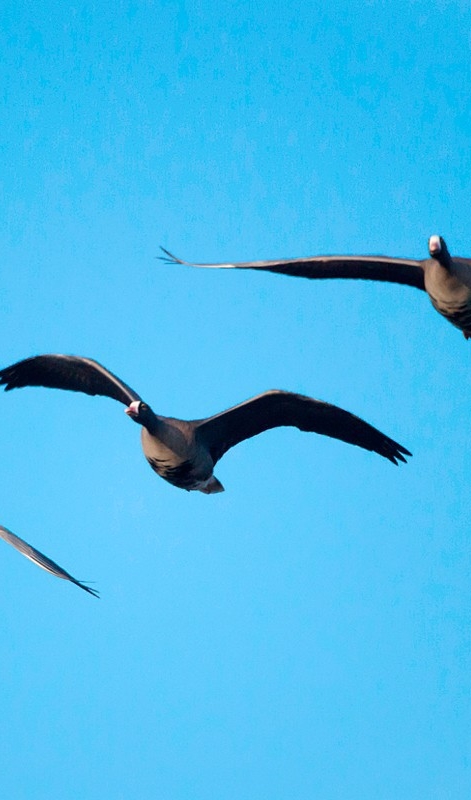

Complicated migration routes
The migration routes of the Lesser White-fronted Geese were mapped by the previous LWfG LIFE project by equipping a couple of adult individuals with a lightweight satellite transmitter. The map is summing up the present knowledge on the routes and stopover sites of the Fennoscandian LWfG.
In autumn, the Fennoscandian Lesser White-fronts first fly to the Russian Kanin Peninsula and from there they divide, taking two different routes: the European route (blue arrows) via Hungary to Greece, or the Central Asian route (red arrows) via Russia, Kazakhstan and Ukraine to Greece. In spring they have a different, straight route (green arrows) from Greece via Hungary, Lithuania, Estonia and Finland back to the breeding areas.
One of the major findings of the previous LWfG LIFE project was that the choice of the autumn migration route is determined by the breeding success. The goose families with young are likely to choose the European route, while birds that did not manage to produce offspring can moult in Russia (light blue arrows) and are likely to choose the more dangerous Central Asian autumn migration route.
This has a direct implication for conservation: it’s very important to try to ‘support’ successful breeding in Fennoscandia e.g. by controlling the Red Fox population in the breeding areas. Successful breeding contributes to recruitment of new individuals to the small population and – at the same time – to increased adult survival.
In Fennoscandia, the LWfG arrive at the breeding sites in the end of May – beginning of June, and the autumn migration starts (as soon as the juveniles have fledged, and the breeding adults have finished the moult) in mid-August. The average schedule of the migration is roughly the following:
- early June – early August: breeding areas
- August: staging areas in northern Norway
- September: Kanin Peninsula, Russia
- October: Hungary
- November/December-March: Greece
- March-April: Hungary
- mid-April – early May: western Estonia
- mid-May: Finnish Bothnian Bay coast
- late May – early June: Valdak Marshes and other staging areas in Finnmark, Norway
The following wintering / staging sites along the European migration route are known:
- Evros Delta (Greece, and possibly also Turkey?)
- Lake Kerkini, Nestos Delta, Lake Mitrikou (Greece)
- Hortobágy, Biharugra, Kardoskút (Hungary)
- Galenbecker and Putzarer See (Germany)
- Nemunas Delta (Lithuania)
- Matsalu, Silma, Nigula (Estonia)
- Hailuoto–Liminganlahti (Finland)
- Stabbursnes, Varangerfjord (Norway)
- Kanin Peninsula, Russia
Most likely some (especially spring) staging sites in between the known sites still remain unknown. To improve the conservation status of the Lesser White-fronted Goose along the European migration route, it is essential to locate the unknown staging areas, and to improve the protection status of the species at the known sites.

